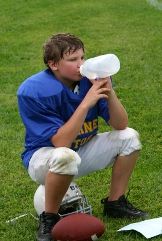NATA has released an executive summary of a revised position statement on exertional heat illnesses to published in an upcoming issue of the Journal of Athletic Training, NATA's scientific publication.*

"Exertional heat illnesses are largely preventable within the confines of organized sports when appropriate protocols are put into place," said Douglas J. Casa, PhD, ATC, FACSM, FNATA, chief operating officer of the Korey Stringer Institute, director of Athletic Training Education, Department of Kinesiology at the University of Connecticut and chair of the position statement writing group. [Note: Casa is also a member of MomsTEAM Institute's Board of Advisors, which is developing best practice guidelines, including on exertional heat illness, as part of the Institute's SmartTeams Play Safe initiative.
"This includes heat acclimatization, body cooling, hydration, modifying of exercise based on environmental conditions, among other considerations. These guidelines are not just for athletes - they are also valuable for individuals exposed to warm weather environments such as those in the military or individuals whose work necessitates heat exposure."
Exertional heat stroke is one of the three leading causes of death in sport (and the leading cause in the summer). The period of 2005 to 2009 had more heat stroke deaths than any other five year period in the 35 years prior. There were 18 deaths from 2005 to 2009; from 2010 to 2014 (still being tracked) there are now an estimated 20 to 22 deaths.
Executive Summary Select Highlights
Prevention of Exertional Heat Illnesses:
- A pre-season heat acclimatization policy should be implemented to allow athletes to be acclimatized to the heat gradually over a period of 7 to 14 days. This is optimal for full heat acclimatization.
- Plan rest breaks and modify the work-to-rest ratio to match environmental conditions and the intensity of the activity.
Recognition of Exertional Heat Illnesses:
- The two main diagnostic criteria for exertional heat stroke are profound central nervous system (CNS) dysfunction and a core body temperature above 105°F. [For other signs of heat stroke, click here]
- Rectal temperature is the only method of obtaining an immediate and accurate measurement of core body temperature in an exercising individual.
Treatment of Exertional Heat Illnesses:
- The goal for any exertional heat stroke victim is to lower core body temperature to less than 102.5°F within 30 minutes of collapse.
- Cold water immersion is the most effective way to treat a patient with exertional heat stroke. The water should be 35-59°F and continuously stirred to maximize cooling.
Updated Findings
Specific recommendations for pre-season heat acclimatization protocol:
- Days 1-2: Single three hour practice OR single two hour practice and single one hour field session; only helmets may be worn
- Days 3-4: Single three hour practice OR single two hour practice and single one hour field session; only helmets and shoulder pads may be worn
- Day 5: Single three hour practice OR single two hour practice and single one hour field session; full equipment may be worn
- Days 1-5: Equipment guidelines for preseason participation only impact days 1-5 of the acclimatization period
Recommendation of assessing rectal temperature if exertional heat stroke is suspected:
Best practices strongly advise the use of rectal temperature for the assessment of body temperature in a suspected exertional heat stroke patient. It is discouraged to use inaccurate devices such as oral, tympanic, etc.
Specific protocol for the treatment of exertional heat stroke:
The new guidelines suggest a specific step-by-step protocol for cold water immersion for the clinician to implement with an exertional heat stroke patient. This protocol is backed by research exhibiting a 100 percent survival rate when initiated quickly and properly.
Identification of approximate cooling rates for an exertional heat stroke patient:
While cooling rates may vary, the cooling rate for cold water immersion will be approximately 0.37°F/min. or about 1°F every three minutes when considering the entire immersion period for an exertional heat stroke patient. This provides an approximate treatment time for clinicians if rectal temperature monitoring is not possible during treatment.
Recommendation of "cool first, transport second":
- The current document now states that a patient suspected of having exertional heat stroke must be cooled via cold water immersion for the full treatment time prior to being transported to a hospital; and that this must be stated in the school's emergency action plan.
- A substantial revision of tables and figures have been amended to provide more clinically-applicable information.
Removal of hyponatremia as an exertional heat illness:
Hyponatremia was removed from the current guidelines as this condition is not considered to be a true heat-related illness.
"Death from exertional heat stroke is 100 percent preventable when proper recognition and treatment protocols are implemented," concluded Casa. "Putting the right programs into place is essential to prevent and treat exertional heat illnesses and ensure appropriate care is in place."
* The updated position statement is now slated to be released in August/September 2015, according to Casa.
Source: National Athletic Trainers' Association
Updated July 22, 2015








